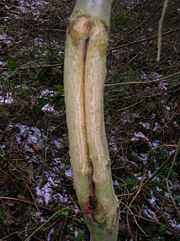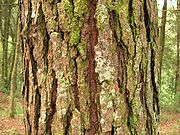
Frost crack
Encyclopedia
Frost crack is a form of tree
bark damage sometimes found on thin barked trees, visible as vertical fracture
s on the south
erly facing surfaces of tree trunks. Frost crack is distinct from Sun scald and Sun crack and physically differs from normal rough-bark characteristics as seen in mature oak
s, pine
s, poplar
s and other tree species.
 The sloughing or peeling of the bark is a normal process, especially in the spring when the tree begins to grow. The outer layers of the bark are dead tissue and therefore they cannot grow, the outer bark splitting in order for the tree to grow in circumference, increasing its diameter. The inner bark cambium and phloem tissues are living, and form a new protective layer of cells as the outer bark pulls apart.
The sloughing or peeling of the bark is a normal process, especially in the spring when the tree begins to grow. The outer layers of the bark are dead tissue and therefore they cannot grow, the outer bark splitting in order for the tree to grow in circumference, increasing its diameter. The inner bark cambium and phloem tissues are living, and form a new protective layer of cells as the outer bark pulls apart.
Normal furrowed bark has a layer of bark over the wood below, however bark may peel or fall off the tree in sheets (river birch), plates (sycamore and pine), strips (cedar) or blocks (dogwood).
Research suggests that the main cause is actually 'frost-shrinkage' due to the freezing-out of cell well moisture into lumens of wood cells and other causes are the expansion of freezing water in cell lumens, and additionally the formation of ice lens
es within wood. As stated, previous defects such as healed wounds, branch stubs, etc in tree trunks function as stress raisers and trigger the frost cracking.
In winter when the sun sets or the sky clouds over, the temperature of the tree drops very quickly and as the bark cools more quickly and the wood contracts more slowly, the bark rips open in a long crack, sometimes with an audible report likend to a rifle crack. Cold, clear, sunny days are the most likely to result in frost cracking, particularly as the heat energy from the low Sun on a Winter day can be higher than any other time of year.
Trees that are growing in poorly drained sites are more subject to frost cracking than are those growing in drier, better drained soils. Trees suddenly left exposed by felling are highly susceptible.
 Although frost cracks may be up to several metres long, these cracks usually only become apparent in early spring; they are often found on the southwest side of the tree. These cracks may heal in the summer and be reopen again in the winters, so that successive cracking and healing over a number of years results in the formation of 'frost ribs' on the sides of affected trees. The wood beneath the frost crack is rarely damaged. The cracks usually originate at the base of the trunk and extends from a metre to several metres upwards. Some discoloration is often found at the site of the damage.
Although frost cracks may be up to several metres long, these cracks usually only become apparent in early spring; they are often found on the southwest side of the tree. These cracks may heal in the summer and be reopen again in the winters, so that successive cracking and healing over a number of years results in the formation of 'frost ribs' on the sides of affected trees. The wood beneath the frost crack is rarely damaged. The cracks usually originate at the base of the trunk and extends from a metre to several metres upwards. Some discoloration is often found at the site of the damage.
 Species such as Crab-apple, Beech, Walnut, Oaks, Maples, Sycamore, Horse-chestnut, Willows and Lime are prone to developing Frost crack given the right conditions.
Species such as Crab-apple, Beech, Walnut, Oaks, Maples, Sycamore, Horse-chestnut, Willows and Lime are prone to developing Frost crack given the right conditions.
. The wound’s edges begin to form this callus during the first growing season after that crack appears and the callus layer will continue to grow and after many years, the wound may close over entirely.
Tree
A tree is a perennial woody plant. It is most often defined as a woody plant that has many secondary branches supported clear of the ground on a single main stem or trunk with clear apical dominance. A minimum height specification at maturity is cited by some authors, varying from 3 m to...
bark damage sometimes found on thin barked trees, visible as vertical fracture
Fracture
A fracture is the separation of an object or material into two, or more, pieces under the action of stress.The word fracture is often applied to bones of living creatures , or to crystals or crystalline materials, such as gemstones or metal...
s on the south
South
South is a noun, adjective, or adverb indicating direction or geography.South is one of the four cardinal directions or compass points. It is the opposite of north and is perpendicular to east and west.By convention, the bottom side of a map is south....
erly facing surfaces of tree trunks. Frost crack is distinct from Sun scald and Sun crack and physically differs from normal rough-bark characteristics as seen in mature oak
Oak
An oak is a tree or shrub in the genus Quercus , of which about 600 species exist. "Oak" may also appear in the names of species in related genera, notably Lithocarpus...
s, pine
Pine
Pines are trees in the genus Pinus ,in the family Pinaceae. They make up the monotypic subfamily Pinoideae. There are about 115 species of pine, although different authorities accept between 105 and 125 species.-Etymology:...
s, poplar
Poplar
Populus is a genus of 25–35 species of deciduous flowering plants in the family Salicaceae, native to most of the Northern Hemisphere. English names variously applied to different species include poplar , aspen, and cottonwood....
s and other tree species.
Normal bark formation

Normal furrowed bark has a layer of bark over the wood below, however bark may peel or fall off the tree in sheets (river birch), plates (sycamore and pine), strips (cedar) or blocks (dogwood).
The Causes of Frost Crack
Frost cracks are frequently the result of some sort of weakness in the bark which occurred to the tree earlier. In late winter and early spring, water in the phloem, known as the inner bark and in the xylem, known as the wood, expands and contracts under often significantly fluctuating temperatures. Wood that is some way damaged does not contract to the same degree as healthy wood. Rapid expansion and contraction of water within the wood and bark, particularly under rapidly falling night temperatures, can result in a frost crack, often accompanied by a loud explosive report.Research suggests that the main cause is actually 'frost-shrinkage' due to the freezing-out of cell well moisture into lumens of wood cells and other causes are the expansion of freezing water in cell lumens, and additionally the formation of ice lens
Ice lens
An Ice Lens or ice lenses are formed when moisture, diffused within soil or rock, accumulates in a localized zone. The ice initially accumulates within small collocated pores or pre-existing crack, and, as long as the conditions remain favorable, continues to collect in the ice layer or ice lens,...
es within wood. As stated, previous defects such as healed wounds, branch stubs, etc in tree trunks function as stress raisers and trigger the frost cracking.
In winter when the sun sets or the sky clouds over, the temperature of the tree drops very quickly and as the bark cools more quickly and the wood contracts more slowly, the bark rips open in a long crack, sometimes with an audible report likend to a rifle crack. Cold, clear, sunny days are the most likely to result in frost cracking, particularly as the heat energy from the low Sun on a Winter day can be higher than any other time of year.
Trees that are growing in poorly drained sites are more subject to frost cracking than are those growing in drier, better drained soils. Trees suddenly left exposed by felling are highly susceptible.
Physical appearance

Effect of damage
Frost cracks often act as sites of entry for wood decay organisms, including insects, fungi and bacteria. Timber damaged in this way is unsuitable for use in buildings, etc.Tree species susceptibility

Prevention of Frost Cracks
Avoiding the use of fertilizers late in the growing season can reduce the incidence of splits, also protecting the bark of young trees from physical damage such as that caused by lawn mowers, car bumpers, grazing animals, spades, strimmers, etc. Protect young trees in winter with paper tree wrap from ground level to the first main branches.Repair
Most tree species try to seal the edges of wounds by forming a callus layerCallus
A callus is an especially toughened area of skin which has become relatively thick and hard in response to repeated friction, pressure, or other irritation. Rubbing that is too frequent or forceful will cause blisters rather than allow calluses to form. Since repeated contact is required, calluses...
. The wound’s edges begin to form this callus during the first growing season after that crack appears and the callus layer will continue to grow and after many years, the wound may close over entirely.

